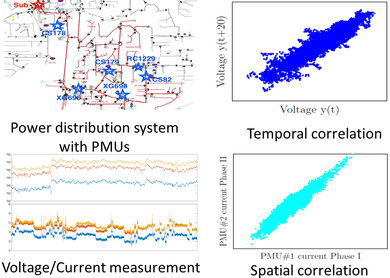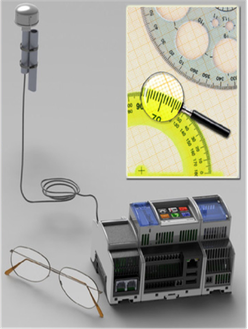|
Machine Learning for Online Diagnostics
 |
The smart grid revolution is mostly creating a paradigm shift in distribution networks that is marked by significant intermittency
and uncertainty in electricity supply and demand. These developments dramatically increase adoption of distributed energy resources
(DER), electric vehicles, energy storage, and controllable loads. However, this transformation imposes different challenges on existing
distribution infrastructure and system operation for stockholders, engineers, operators and customers. To address the new challenges,
we develop fast and robust machine learning algorithms to analyze heterogeneous and spatiotemporal data streams from various
sensors such as smart meters, synchrophasor, and power quality recorders along with weather data and GIS databases.
We are specifically working on online unsupervised learning tools for event detection in the authority distribution networks.Optimal
feature selection, shape-based data analysis, and multilevel hidden Markov chain methods are used in our software tool for event detection
using real microsynchorphaser and smart meter data set from different utilities.
Grants:
Florida State Council on Research and Creativity
|
Selected Publications:
6. Y. Zhou, R. Arghandeh, and C. J. Spanos. Online Learning of Contextual Hidden Markov Models for Temporal-Spatial Data Analysis. In 2016 IEEE Control
Systems Society Conference Management System (CDC 2016), 2016.
5. Y. Zhou, R. Arghandeh, I. C. Konstantakopoulos, S. Abdullah, A. von Meier, and C. J. Spanos. Online method for measurement data analysis in power
distribution networks. In ASME Power and Energy Conference 2016, 2016.
4. Y. Zhou, R. Arghandeh, I. C. Konstantakopoulos, S. Abdullah, A. von Meier, and C. J. Spanos. Distribution network event detection with ensembles of
bundle classifiers. In IEEE PES General Meeting 2016, 2016.
3. Y. Zhou, R. Arghandeh, I. C. Konstantakopoulos, S. Abdullah, A. von Meier, and C. J. Spanos. Abnormal event detection with high resolution micro-pmu
measurement. In IEEE Power Systems Computation Conference. IEEE, 2016.
2. Y. Zhou, R. Arghandeh, I. C. Konstantakopoulos, S Abdullah, and C. J. Spanos. Data-driven event detection with partial knowledge: A hidden structure
semi-supervised learning method. In IEEE, editor, American Control Conference (ACC16), 2016.
1. J. Poon, I. C. Konstantakopoulos, R. Arghandeh, A. von Meier, C. Spanos, S. Sanders, “Model-Based Fault Diagnosis for Smart Buildings and Power
Distribution Networks,” Submitted to 9th IFAC Symposium on Fault Detection, Supervision and Safety for Technical Processes SAFEPROCESS’15, Paris, France,
Sep 2015.
Micro-Synchrophasors and Future of Distribution Networks Monitoring
 |
Today's electric power distribution systems have limited observability and diagnostic capabilities. In high-voltage power transmission, visibility and situational
awareness have been a vital area for technological R&D and investment in recent years. Distribution systems are lagging several decades behind, for good reason:
there was historically no need, nor a business case, to develop similar capabilities. Owing to the relative simplicity of power distribution i.e., mostly radial
layout of circuits with one-way power flow it was necessary only to evaluate the envelope of design operating conditions (such as peak loads or fault currents)
rather than continually observe the actual operating state. Accordingly, legacy distribution circuits are equipped with little instrumentation beyond the substation.
But the growth of distributed energy resources (DER) such as solar photovoltaics, electric vehicles, automated demand response and distributed storage introduces
significant variability and new uncertainties, as well as opportunities to recruit diverse resources for grid services. This development dramatically increases the
need and value proposition for tools to better observe, understand and manage the grid at the distribution scale. To address this need, our team at UC Berkeley, in
conjunction with Lawrence Berkeley National Lab (LBNL), and Power Standards Lab, are developing a novel high-precision phasor measurement unit with GPS time-stamping
called the micro-synchrophasor or microPMU. We have received an award from the U.S. Department of Energy,s ARPA-E program for a three-year project to develop a high-
precision phasor measurement unit called a micro-synchrophasor or microPMU, and to study its applications for diagnostic and control purposes in distribution systems.
|
Selected Publications:
5. R. Arghandeh, A. von Meier, “Diagnostic Applications for Micro-Synchrophasor Measurements,” California Institute for Energy and Environment, prepared for U.S.
Department of Energy, Advanced Research Projects Agency-Energy (ARPA-E), Award number 000340, , April 2014.
4. A. von Meier, R. Arghandeh, “Chapter 34: Every Moment Counts; High Resolution Measurement for Distribution Network with Variable Sources,” Chapter in the Renewable
Energy Integration: Practical Management of Variability, Uncertainty and Flexibility, L. E. Jones, Ed., ed Netherlands: Elsevier, 2014.
3. E.M. Stewart, S. Kiliccote, D. Arnold, A. von Meier , R. Arghandeh, “Accuracy and Validation of Measured and Modeled Data for Distributed PV Interconnection and
Control”, IEEE Power and Energy Society General Meeting, Denver, CO, Jul 2015,
2. E. Stewart, S. Kiliccote, R. Arghandeh, A. von Meier, “Addressing the Challenges for Integrating Micro-Synchrophasor Data with Operational System Applications”,
IEEE Power and Energy Society General Meeting, Washington, DC, Jul 2014,
1. A. von Meier, D. Culler, A. McEachern, R. Arghandeh, “Micro-Synchrophasors for Distribution Systems,” IEEE 5th Innovative Smart Grid Technologies Conference,
Washington D.C., Feb 2014.
|

